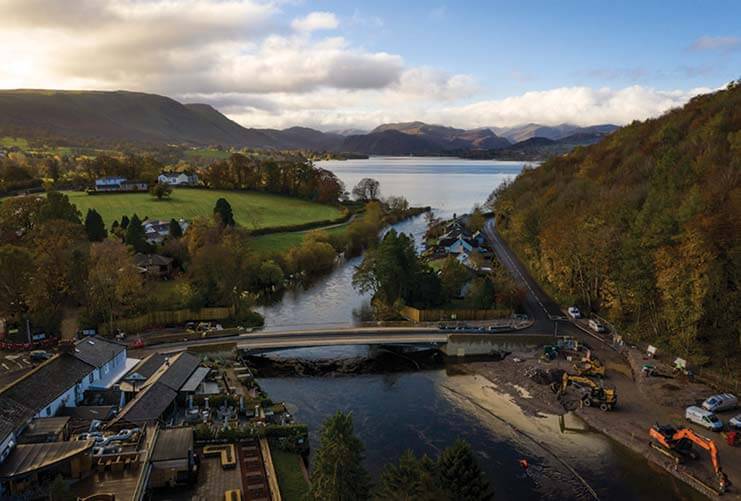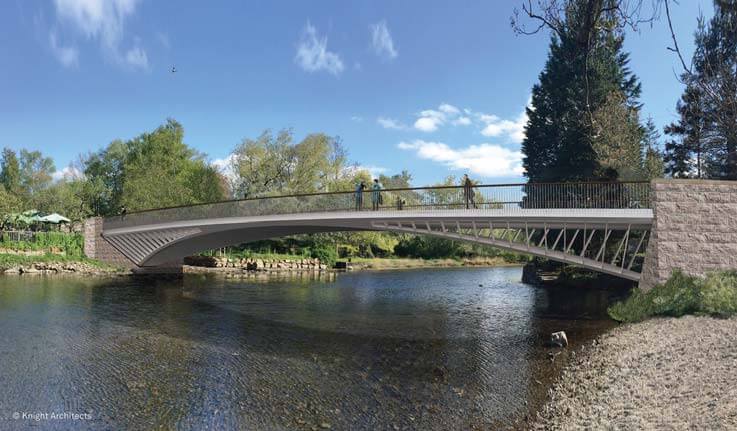The new Pooley bridge installed and opened to traffic. Photo courtesy of Outokumpu.
Article by Andy Backhouse, Outokumpu
As the UK’s first stainless steel road bridge, Pooley Bridge is a landmark structure that opened in autumn 2020. The selection of Outokumpu’s Forta LDX 2101 duplex stainless steel was an important factor in creating a slender and elegant bridge, not least for its setting in England’s Lake District National Park, a UNESCO World Heritage site. Andy Backhouse, Lead Technical Manager at Outokumpu describes the project.
The original Pooley Bridge was built in 1764 and had three traditional stone arches. It was swept away by Storm Desmond, a one-in-700-year storm in December 2015. This caused the village of Pooley Bridge to lose part of its identity, as well as a vital road link. During the torrential rainfall and high river levels, pressure built up on the stone piers and caused the entire bridge to be washed away.
Cumbria County Council appointed specialist bridge designers Knight Architects to create a fitting replacement, designed through a consultation process with the community.
With the village being named after the bridge, the council wanted the community to be involved in the project. Its priorities were for the new bridge to minimize the risk of future flooding, to include traditional Lake District stonework and that people should be able to see the landscape clearly through the bridge. It was also important to minimize the impact of construction on the river.
Knight Architects put forward three design options in multiple materials including stainless steel, painted carbon steel, weathering steel, concrete and stone, with Outokumpu providing advice from the early stages of the project. Local people expressed a preference for the design with the lowest visual impact and for materials that would require little or no maintenance.

The original stone bridge, now washed away. Photo courtesy of Peter McDermott.
Slender and transparent structure
Using the feedback, Knight Architects progressed with a design based on a composite arch bridge made from stainless steel and concrete. Duplex stainless steel was chosen as it met the community’s wish for a long-life material with the additional benefit that it is at least 25-30 percent stronger than S355 carbon steel. This gave the ability to design the most slender bridge possible.
A single span slender structure helps the bridge appear transparent so that people can see the landscape through it. However, it’s also practical as it allows the river to flow more freely. Stainless steel is also more tolerant of debris impacts than other materials, which is an important consideration during periods of fast flowing storm waters.
Novel design
The bridge required some novel thinking from structural engineers at consultancy GHD during the detailed design phase. Usually, a composite bridge’s concrete deck sits on top of steel beams. However, in the case of Pooley Bridge, the deck is supported by a concrete and steel arch, with the sides of a concrete arch connecting with stainless steel framework.
Corrosion resistance
Another factor that was required that favors duplex stainless steel is its corrosion resistance. This means the bridge will remain in good condition without repainting, which reduces maintenance and Life Cycle Cost. It also avoids the need for sandblasting and repainting over the river: an important point in a National Park.
Winter in northwest England often brings snow and freezing conditions, and as the bridge is on a main road, the local authority makes regular use of de-icing salt. Guidance on the selection of structural stainless steels for this type of environment is given in Eurocode 3, EN1993-1-4 Annex A, and based on this the lean duplex grade Forta LDX 2101 was selected. This grade is ideal for river crossings in inland rural environments and temperate climates and is expected to fully withstand the de-icing salt use. It has the advantage of having lower nickel content than other grades of stainless steel – and this leads to more predictable and lower costs which was important for the project budgeting.
Sustainability
A main focus of sustainability in structures today is the embodied carbon footprint of materials used. The high strength of duplex stainless steel minimized the amount of steel and concrete used for Pooley Bridge – minimizing concrete is particularly desirable from a carbon footprint viewpoint. Furthermore, Outokumpu’s stainless steel also helped to enhance the project’s sustainability credentials thanks to its 85% recycled content and low embodied CO2.

The new bridge shortly after installation in the Lake District National Park, photographed by a drone camera. Photo courtesy of Mike Smith / Outokumpu.
Fabrication
Although a few duplex stainless steel pedestrian bridges have been built previously in the UK, this project was both the first road bridge and the largest stainless bridge project in the UK to date. As a consequence, only a few UK fabricators had the right combination of stainless steel experience, trained welders and size of facility to undertake the work. WEC Ltd in Darwen was appointed and used Forta LDX2101 quarto plates from Outokumpu’s mill in Degerfors, Sweden.
The steel structure was built in four sections and a matt surface finish was selected to fit with the rural location. It was achieved by grinding the welds flat and sand blasting the entire surface of the finished fabrication for a uniform appearance. The final assembly together with the concrete deck took place at site and the whole 55m long, 300 tonne steel-concrete structure was lifted into place as a single piece.
A bridge for the community
A road bridge is often designed with substantial impact barriers to contain traffic. In this case, Knight Architects specified 300mm high kerbs for the pedestrian pavements instead of a traditional barrier. As a result, the architects were able to create a very transparent stainless steel balustrade, which lets people see the landscape and contributes to the slender and elegant overall appearance of the bridge. Because stainless steel resists corrosion, the bridge will retain its good looks over time. This is a significant benefit to architects, who cannot always influence the maintenance and repair of structures once they are in place.
The project was important to establish stainless steel as a material for road bridges in the UK. With Pooley Bridge in place as a reference, it is likely that more workshops in the UK will see an opportunity to enter the market. In turn, this will give architects and their clients more commercial options, making stainless steel a more viable material for bridges.
The original Pooley Bridge was an icon for over 250 years. With the help of modern duplex stainless steels, the new bridge is a fitting replacement that should last just as long.

The new bridge as conceived by Knight Architects. Courtesy of Knight Architects.

The duplex bridge being lifted into place. Photo courtesy of Cumbria Country Council / Eric Wright.
“Every week we share a new Featured Story with our Stainless Steel community. Here you are provided with an online abstract, the full story features in our print and digital magazine. Join us and let’s share your Featured Story on Stainless Steel World online and in print.”
– FEATURED STORY BY JOANNE MCINTYRE
All images were taken before the COVID-19 pandemic, or in compliance with social distancing.
Read the full article.


